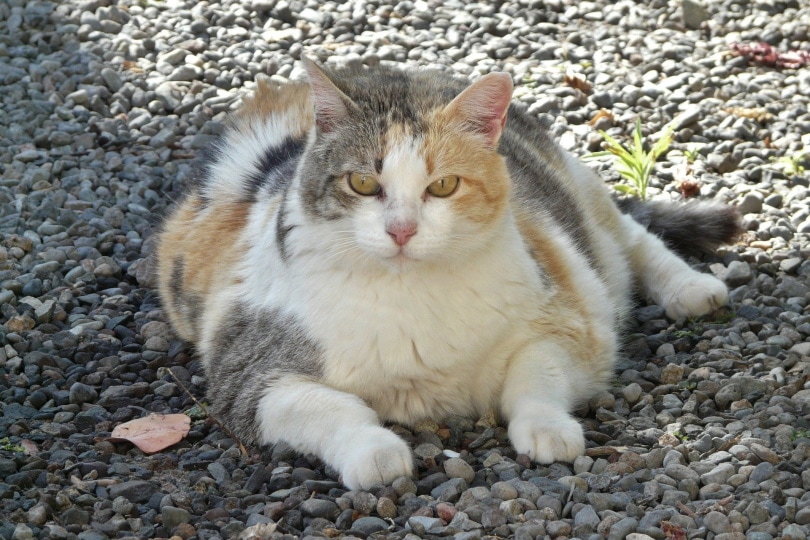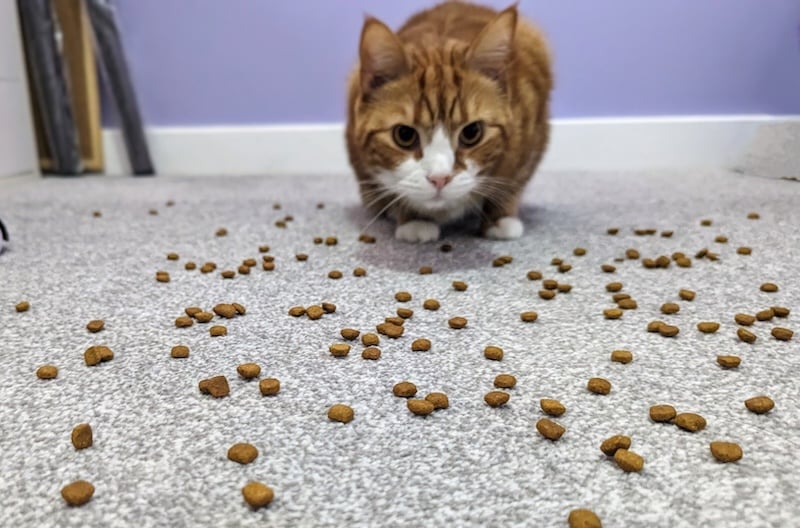Cats are one of America’s favorite pets, but as more of them spend their lives indoors, they are also putting on more weight. Obesity can lead to several health problems, but most importantly, it shortens their lives. If you want to keep your pet healthy but aren’t sure how to tell if they are overweight, we are here to help. The average house cat should weigh 8–10 pounds (3.6–4.4 kg). But there are multiple factors that may change these values, so keep reading while we discuss how to determine the ideal weight for your cat and how to make adjustments so your cat can live a long, healthy life.
We’ve broken up your cat’s weight into five categories to help you determine if your cat is overweight and answer the age-old question, “How heavy should my cat be?”
Click to skip ahead:
- Weight Categories
- Weight Chart
- Ideal Weight
- How to Identify If Your is Healthy
- What to Do If Your Cat Is Overweight
- What to Do if Your Cat is Underweight


Cat Weight Categories
1. Critically Underweight
Very underweight cats need immediate attention. It’s rare to see a cat in this condition unless it is a stray or someone has been neglecting it. Very underweight cats will have visible ribs that you can see from the side and also from above. The bones around the tail will have no fat covering and are more prominent than usual. The tummy tuck will be extreme, and they usually have little energy for grooming, hunting, or playing. If it’s a stray, it will lose its fear of humans and come up to you looking for food.
2. Underweight

Underweight cats will have a little more fat than the previous type, but not much. You will still see rib bones from the side, and they will be easy to feel when you pet the cat, but it may be more difficult to see them from above.
There will be some padding on the bones around the tail, but they will still be prominent and easy to see, along with a very obvious tummy tuck. Though they are underweight and need food immediately, they will still have plenty of energy to hunt and play and may even choose to hide or run from humans when confronted. Most stray cats are underweight, especially if there is a large population or it’s winter.
3. Ideal Cat Weight

Cats at their ideal weight will have ribs that you can feel without effort when you pet them, but they won’t be visible unless they are stretching, jumping, or climbing. The hip bones will be padded but contoured and visible, creating a slight waist for the cat when looking down on it from above. Its fur will be shiny, and the cat will be playful and energetic. Cats in this weight range will live the longest, but it takes the most effort from pet owners to achieve.
4. Overweight

Overweight cats are easy to find in many homes across America, outnumbering those cats at an ideal weight and becoming a serious issue. You will still be able to feel the ribs of an overweight cat, but it will require a little pressing, and you will also feel the fat. You will see the hip bones are well padded, and the body will bulge slightly towards the back with no waistline when viewed from above.
5. Obese

Like very underweight cats, obese cats require immediate attention. They are vulnerable to several health issues, including heart disease, diabetes, kidney disease, and more. The extra weight will also take a toll on the joints and will make it hard for your cat to climb and jump as it normally would. The added fat can also make it difficult to expand the lungs and breathe normally. You may also notice the cat snoring more often. It will be difficult to feel the ribs on an obese cat, and you will see clear fat deposits on the lumbar area, face, and limbs.
There will be no visible waist, a prominent rounded abdominal area with thick fat padding, and the back end will bulge out when viewed from above.

Cat Weight Chart: How Heavy Should My Cat Be?
| Physical Traits | |
| Very Underweight | ● Dull fur ● Visible ribs ● Non-padded hipbones ● Little energy ● Life-threatening ● Extreme tummy tuck |
| Underweight | ● Ribs visible from the side ● Padding may obscure ribs when viewed from above ● Tummy tucked |
| Ideal | ● Barely visible ribs ● Visible slight waistline when viewed from above ● Shiny coat ● Energetic ● Minimal fat pad in the tummy |
| Overweight | ● No visible ribs ● No waist visible after ribcage ● Rounded abdomen with fat pad ● A slight bulge in the back half when viewed from above |
| Obese | ● No visible ribs ● Visible fat deposits ● Very obviously rounded abdomen, thick fat pad ● Less energy ● Difficulty breathing ● Life-threatening |

Ideal Cat Weight
Many experts recommend that your cat weigh between 10 and 12 pounds, but that’s not always the case. The International Cat Association recognizes more than 70 cat breeds, and each breed will possess different traits, including its ideal weight. For instance, the Singapura cat is one of the smallest cats, and you want it to weigh between 4 and 8 pounds. The Maine Coon is the largest breed, and the females will weigh 12 to 15 pounds, while the males can be as heavy as 22 pounds.
However, the Domestic Shorthair is one of the most common house cats in America, and if you didn’t purchase a specific breed, it is probably a Domestic Shorthair. These cats are normally around 10 pounds, but it can still vary, and you will need to determine the ideal weight for your cat on a case-by-case basis.
Now how often should you weigh your cat? Award-winning writer and cat expert, Ingrid King, recommends that you weigh your cat once a month as weight loss or gain can be an early sign of warning sign of illness.

How to Identify If Your Cat’s Weight is Healthy
The best way to determine if your cat is the proper weight is to use our image guide above and do a visual test. You should not see any fat deposits on the cat, but you shouldn’t see the ribs, especially when looking at the cat from above. It should have a shiny coat that it grooms often, and it should have plenty of energy and like to play. Its breathing should not seem labored, and it should be able to jump on high counters fairly easily.
Cats that are too heavy may have difficulty grooming themselves and may develop mats, especially if they have long hair. They will stop trying to leap on high counters and not run as much. Their breathing can sound labored, and they will be more likely to snore. Fat deposits will be visible and especially noticeable when the cat runs.

What to Do If Your Cat Is Overweight
Unfortunately, it is not easy to help your cat lose weight, and it is preferable to prevent your cat from getting fat in the first place. Cats can quickly develop fatty liver disease if you try to make them lose weight too fast. Fatty liver disease affects your cat’s ability to process blood and could be life-threatening.
- Feed high-quality cat food with plenty of animal-based protein, and avoid grains. Eliminate foods with corn and soy ingredients.
- Feed your cat three or four small meals throughout the day instead of giving them food when they want it.
- Spend a few more minutes each day playing with your cat to get them to be more active. Laser pens are great ways to get your cat to run.
- Take your cat to the vet to get their recommendation.
What to Do if Your Cat is Underweight
If your cat is underweight, first check the quality of the food. The main ingredient should be animal protein. It should also contain a moderate amount of healthy fats and few carbs. You can then consider feeding them a bit more food. Cats love to eat, so if your cat is too thin despite proper feeding, it could be a sign that your cat has a health condition that might need attention from a vet. Dental problems, intestinal parasites, diabetes, hyperthyroidism, and even bad food can all be the reason your cat is losing weight unexpectedly.

Conclusion
We hope you have enjoyed reading this guide and learned whether or not your cat is in a healthy weight range. Most modern house cats are suffering from obesity, and we need to get this serious problem under control. The right amount of calories from nutritious food, and plenty of playtimes are the best way. If you know any people with cats that can benefit from this information, please share this guide to how much your cat should weigh on Facebook and Twitter.
See also:
- 6 Homemade Cat Ice Cream Recipes (Vet Approved)
- Cat Hiccups: Why They Happen & What to Do About Them (Vet Answers)
Featured Image: Julia Shepeleva, Shutterstock






